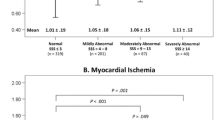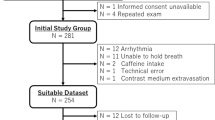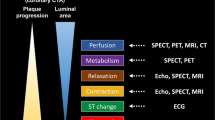Abstract
The determination of the myocardium at risk before intervention and the change in that region after intervention constitute a promising measurement tool for the assessment of acute therapy. A new99mTc labeled myocardial blood flow tracer,99mTc tetrofosmin, is expected to enable the evaluation of myocardium at risk because of the absence of redistribution. This preliminary study was performed in 9 patients with acute coronary syndrome (4 unstable angina and 5 acute myocardial infarction) to investigate whether recovery of perfusion by tetrofosmin imaging parallels mechanical improvement. Tetrofosmin imaging was performed acutely and 3–30 days later. Visual analysis of defect severity was assessed in both studies. Segments with improvement in perfusion were accompanied by significant wall motion recovery compared with normal and unimproved segments (Δ WMI: normal segments 0.40±0.67, improved segments 1.79±0.68, unimproved segments −0.15±0.16, p< 0.01 for improved segments compared with other groups), suggesting the efficacy of this tracer for the assessment of the acute therapy. These data suggest that99mTc tetrofosmin imaging is a useful method for the assessment of the myocardial area at risk and the efficacy of acute therapy in acute myocardial infarction and unstable angina.
Similar content being viewed by others
References
Reimer KA, Idekar RE, Jennings RB: Effect of coronary occlusion site on ischemic bed size and collateral blood flow in dogs.Cardiovascular Res 15: 668–674, 1981
Lowe J, Reimer KA, Jennings RB: Experimental infarct size as a function of the amount of myocardium at risk.Am J Pathol 90: 363–380, 1978
Feiring AJ, Johnson MR, Kioschos JM, et al: The importance of the determination of the myocardial area at risk in the evaluation of the outcome of acute myocardial infarction in patients.Circulation 75: 980–987, 1987
Okada RD, Glover D, Gaffney T, et al: Myocardial kinetics of technetium-99m-hexakis-2-methoxy-2-methylpropyl-isonitrile.Circulation 77: 491–498, 1988
Li QS, Frank TL, Franceschi D, et al: Technetium-99m-methoxyisobutyl isonitrile (RP30) for quantification of myocardial ischemia and reperfusion in dogs.J Nucl Med 29: 1539–1548, 1988
Kelly JD, Forster AM, Higley B, et al: Technetium-99m phosphinoether complexes: technetium-99m tetrafosmin as new radiopharmaceutical for myocardial perfusion imaging.J Nucl Med 34: 222–227, 1993
Higley B, Smith FW, Smith T, et al: Technetium-99m 1,2-bis[bis(2 — ethoxyethyl)phosphino]ethane (tetrofosmin); Human biodistribution, Dosimetry and safety of a new myocardial perfusion imaging agent.J Nucl Med 34: 30–38, 1993
Smith FW, Smith T, Gemmell HG, et al: Phase I study of Tc-99m diphosphine (P53) for myocardial imaging.J Nucl Med 32: 967, 1991
Braat SH, Lahiri A, Itti R, et al: Comparison of defect size 5 and 240 mins after injection of tetrofosmin at peak exercise.J Nucl Med 33: 874, 1992
De Coster PM, Wijns W, Cause F, et al: Area at risk determination by technetium — 99m — hexakis — 2 —methoxy-isobutyl isonitrile in experimental reperfused myocardial infarction.Circulation 82: 2152–2162, 1990
Christian TF, Schwartz RS, Gibbons RJ: Determinants of infarct size in reperfusion therapy for acute myocardial infarction.Circulation 86: 81–90, 1992
Christian TF, Gibbons RJ, Gersh BJ: Effect of infarct location on myocardial salvage assessed by technetium-99m isonitrile.J Am Coll Cardiol 17: 1303–1308, 1991
Pfisterer M, MullerBland J, Spring P, et al: Assessment of extent of jeopardized myocardium during acute coronary artery occlusion followed by reperfusion in man using technetium-99m isonitrile imaging.Am Heart J 122: 7–12, 1991
Verani MS, Jerondi MO, Mahmarian JJ, et al: Quantification of myocardial infarction during coronary occlusion and myocardial salvage after reperfusion using cardiac imaging with technetium-99m Hexakis-2-methoxyisobutyl isonitrile.J Am Coll Cardiol 12: 1573–1581, 1988
Simoons ML, Serruys PW, van den Brand M, et al: Improved survival after early thrombolysis in acute myocardial infarction. A randomized trial by the interuniversity Cardiology Institute in Netherland.Lancet 2: 578–582, 1985
The ISAM Study Group: A prospective trial of intravenous streptokinase in acute myocardial infarction (ISAM): mortality, morbidity, and infarct size at 21 days.N Eng J Med 314: 1465–1471, 1986
Serruys PW, Simoons ML, Suryapranata H, et al: Preservation of global and regional left ventricular function after early thrombolysis in acute myocardial infarction.J Am Coll Cardiol 7: 729–742, 1986
O’Neill WW, Timmis G, Bourdillon P, et al: A prospective randomized clinical trial of intracoronary streptokinase versus coronary angioplasty therapy.N Eng J Med 314: 812–828, 1986
Hartzler GO, Rutherford BD, McConahey DR: Percutaneus transluminal coronary angioplasty with and without thrombolytic therapy for the treatment of acute myocardial infarction.Am Heart J 106: 965–973, 1983
Kimura T, Nosaka H, Ueno K, et al: Role of coronary angioplasty in acute myocardial infarction.Am Heart J 107: 820–822, 1984
Weiss AT, Maddahi J, Shah PK, et al: Exercise induced ischemia in the streptokinase-reperfused myocardium: relationship to extent of salvaged myocardium and degree of residual coronary stenosis.Am Heart J 118: 9–16, 1989
Beller GA: Role of myocardial perfusion imaging in evaluating thrombolytic therapy for acute myocardial infarction.J Am Coll Cardiol 9: 661–668, 1987
Beller GA: Noninvasive assessment of myocardial salvage after coronary reperfusion: A perpetual quest of nuclear cardiology.J Am Coll Cardiol 14: 874–876, 1989
Wackers FT, Berman DS, Maddahi J, et al: Technetium-99m hexakis 2-methoxyisobutyl isonitrile: human biodistribution, dosimetry, safety and preliminary comparison to thallium-201 for myocardial perfusion imaging.J Nucl Med 30: 301–311, 1989
Author information
Authors and Affiliations
Rights and permissions
About this article
Cite this article
Matsuo, H., Watanabe, S., Nishida, Y. et al. Assessment of area at risk and efficacy of treatment in patients with acute coronary syndrome using99mTc tetrofosmin imaging in humans. Ann Nucl Med 7, 231–238 (1993). https://doi.org/10.1007/BF03164703
Received:
Accepted:
Issue Date:
DOI: https://doi.org/10.1007/BF03164703




